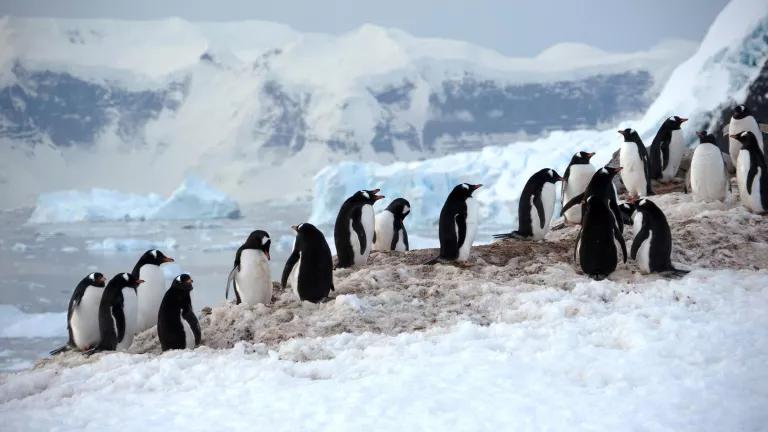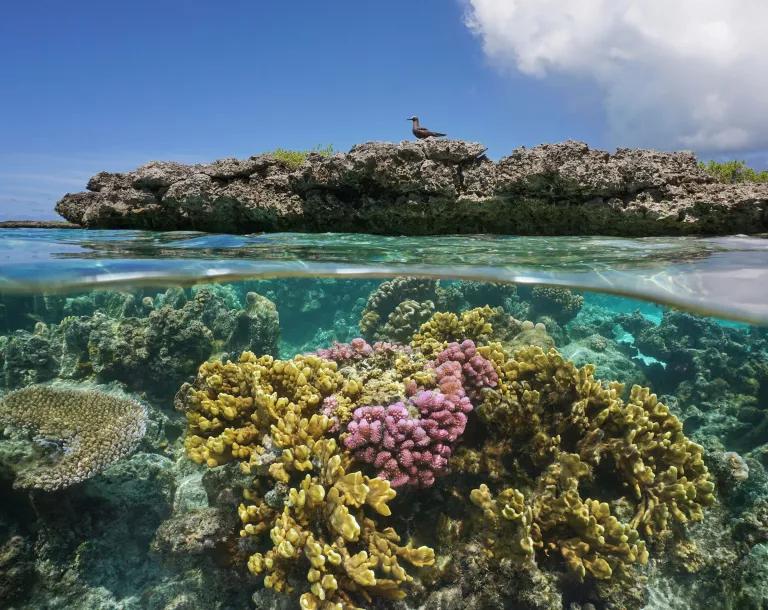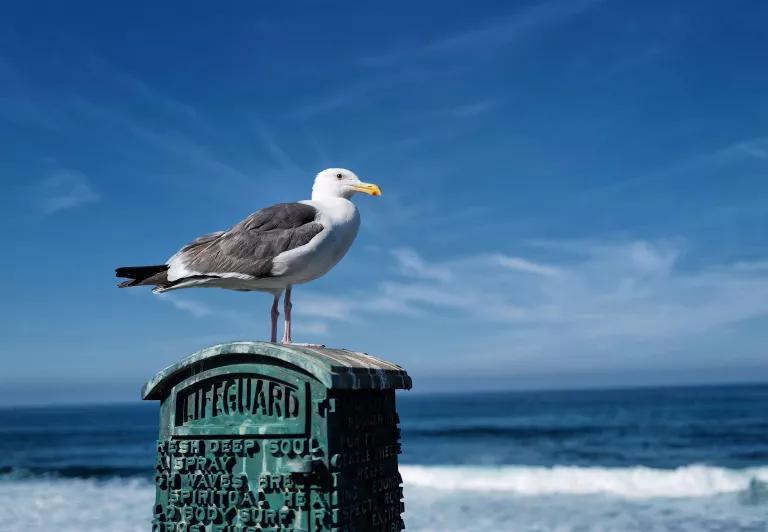The Overlooked Importance of Penguin Poop, Fulmar Feces, and Gull Guano
Seabird droppings don’t just help us fertilize crops; their waste affects everything from coral reefs to climate.

A gentoo penguin colony in Antarctica
When a single seabird relieves itself over the ocean, its waste hits the water and dissolves into the deep. But when an entire colony of seabirds discharges its munitions, the fecal fallout can change the world.
Seabirds tend to get a bad rap but they aren’t all like the gulls that take swipes at your seaside sandwiches. The group includes some 300 species—nearly a third of which are threatened with extinction—from cheeky puffins and adorable sandpipers to devoted penguins and stoic albatrosses.
Now, the frequency at which an animal defecates doesn’t usually do any favors for its reputation among humans, but it should.
When seabirds do their thing overland, their wastes accumulate and dry out, turning into what’s known as guano, which is full of nutrients like nitrogen and phosphorus. This makes it worth big bucks to the fertilizer industry—to the tune of up to $473 million each year, according to a new study published in the journal Trends in Ecology & Evolution. That’s just a conservative estimate based on the market price of guano fertilizer. To fishing communities, the tourism industry, and planetary health, guano is worth even more.
Wherever a seabird’s poop falls—over land or sea—its contribution will help nourish the surrounding ecosystem. Guano on land also tends to wash into the sea, boosting both habitats. For instance, a 2018 study found that the presence of seabirds on islands can increase the biomass of fish communities living around nearby coral reefs by 48 percent. That’s not just good for snorkel tours—humans eat a lot of these fish too. The researchers of the latest study found that when including its beneficial impacts on coral reefs, the monetary value of seabirds skyrockets to $1.1 billion annually.

It may seem uncouth to pin price tags on living things, but estimating the benefits of so-called ecosystem services is all about framing, says Daniel Plazas-Jiménez, an ecologist at the Federal University of Goiás in Brazil and the lead author of the study.
“If I say something like, ‘A seabird deposits 100 tons of nitrogen per year,’ it’s a little difficult for people to understand that,” he says. “But if I talk about how many people depend on jobs that depend on seabirds, that’s something people are interested in.”
And seabirds are just about everywhere the sun touches. They inhabit both poles, the tropics, and far-flung islands that humans have never set foot on. Heck, small storm petrels migrate inland nearly 50 miles from Chile’s Pacific Coast to one of the driest places on earth—the Atacama Desert—where they nest in stinky little holes in the ground.
Through their travels, nearly all seabirds are excellent nutrient cyclers. They haul resources out of the sea (in the form of fish and other prey) and transport them vast distances, releasing them to other seashores and lands. Emperor penguins have become famous for the way they shuffle up to 100 miles into Antarctica’s frozen interior to tend to earth’s most improbable nursery. As they do, the birds lace that pristine white tundra with miles upon miles of crap. And poo from Adélie and other penguins has been linked to rich communities of lichen, moss, insects, and arachnids.
The work of seabirds is thankless, but it doesn’t have to be. With the future of far too many members of this global nutrient cycling army at risk, they need and deserve our help.
The three main threats to seabirds, says Plazas-Jiménez, are climate change (penguins need ice!), death by fishing gear, and the lack of food due to overfishing. And while that first problem will take a while to rectify, he says, the other two are highly solvable with better fisheries management.

Most seabirds become entangled in fishing nets and baited hooks soon after the gear is dropped into the sea. Once caught, they get dragged into the deep. According to one estimate, as many as 300,000 seabirds—including 100,000 albatrosses—die this way each year. But fisherfolk can reduce seabird bycatch by adjusting vessel speed, weighting, and sink rates so that the baits quickly drop below to where most birds can’t dive. They could also avoid fishing in certain areas or at certain times of the day and cut down on fishing strategies that attract birds, such as the practice of throwing out stinky guts, called offal, or the use of blue-dyed baits.
Studies have also shown, predictably, that where intense fishing occurs, nearby seabirds starve. But this, too, could be alleviated by reducing fishing limits and not concentrating fishing activities in areas that seabirds rely on for hunting. And, of course, ensuring that regional and global fishing and other maritime laws are actually enforced would go a long way toward protecting seabirds, fisheries, and people all over the world.
Also, when discussing ocean health, one can’t forget our enormous and ever-growing plastic problem. It is yet another threat for seabirds—even in some of the planet’s most remote places. By now, most people are familiar with the ways plastic ravages a bird’s digestive tract, and images of dead birds with bellies full of brightly colored plastic have driven that point home. But just last month, another study found that birds can digest some of these plastics, causing harmful chemicals to enter their bloodstreams. That’s on top of the plastic-associated chemicals the birds are getting from their fish diets, says the study’s senior author Jan Andries van Franeker, a marine biologist at Wageningen Marine Research in the Netherlands.
As for what’s to be done, van Franeker says everyone, from governments and industry to scientists and consumers, needs to band together to reduce the collective burdens we place on our oceans each day through our outsize consumption and “disposal” of plastic. He says, “this is not just to help these animals—it is equally helping ourselves.”
Echoing that sentiment, Plazas-Jiménez points to the problem of humanity increasingly seeing itself as separate from nature. “We are biological beings, so everything that is happening out there is affecting us too,” he says. “It’s not just about how I use nature, but understanding that I am part of nature.”

We affect seabirds, and they affect us. Scientists conducting research in the Arctic found that ammonia from seabird waste can get sucked into the atmosphere where it combines with water vapor and sulfuric acid to form particles big enough to kick off the creation of low-lying clouds. Incoming sunlight bounces off those clouds and back into space, keeping Arctic waters that much cooler. Plazas-Jiménez says the effect is probably many times greater in the Antarctic, where there are so many more seabirds.
Now, polar seabird guano won’t be enough to single-handedly reverse climate change, but it demonstrates how the world runs on many unexpected connections that we are only just beginning to understand. So the next time you see a flock of seagulls disturbing the peace over a Dorito, give the birds a break. They’re just doing their part—and we desperately need their poop.
This NRDC.org story is available for online republication by news media outlets or nonprofits under these conditions: The writer(s) must be credited with a byline; you must note prominently that the story was originally published by NRDC.org and link to the original; the story cannot be edited (beyond simple things such as grammar); you can’t resell the story in any form or grant republishing rights to other outlets; you can’t republish our material wholesale or automatically—you need to select stories individually; you can’t republish the photos or graphics on our site without specific permission; you should drop us a note to let us know when you’ve used one of our stories.

Biodiversity 101
U.N. Report: A Million Extinctions and Ecological Collapse Are on the Way
How to Become a Community Scientist